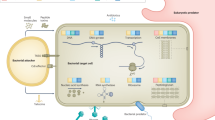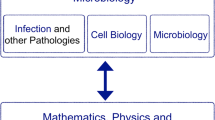Abstract
Koch's postulates were derived from Robert Koch's work on infectious diseases, such as anthrax and tuberculosis, which still engage us to this day. These guidelines were an attempt to establish a standard for identifying the specific causation of an infectious disease and to convince sceptics that microorganisms could cause disease. They were also established to encourage an increasing number of novice microbiologists to use more rigorous criteria before claiming a causal relationship between a microorganism and a disease.
This is a preview of subscription content, access via your institution
Access options
Subscribe to this journal
Receive 12 print issues and online access
$209.00 per year
only $17.42 per issue
Buy this article
- Purchase on Springer Link
- Instant access to full article PDF
Prices may be subject to local taxes which are calculated during checkout


Similar content being viewed by others
References
Falkow, S. Molecular Koch's postulates applied to microbial pathogenicity. Rev. Infect. Dis. 10, S274–S276 (1988).
Fredricks, D. N. & Relman, D. A. Sequence-based identification of microbial pathogens: A reconsideration of Koch's postulates. Clin. Microbiol. Rev. 9, 18–33 (1996).
Evans, S. Causation and disease: the Henle–Koch postulates revisited. Yale J. Biol. Med. 49, 175–195 (1976).
Casadevall, A. & L. Pirofski, L. Host–pathogen interactions: the attributes of virulence. J. Infect. Dis. 184, 337–344 (2001).
Finlay, B. B. & Falkow, S. Common themes in microbial pathogenicity revisited. Microbiol. Mol. Biol. Rev. 61, 136–169 (1997).
Medzhitov, R. & Janeway, C. Jr. Toll receptor family and microbial recognition. Trends Microbiol. 8, 452–456 (2000).
Ozinsky, A. et al. The repertoire for pattern recognition of pathogens by the innate immune system is defined by cooperation between toll-like receptors. Proc. Natl Acad. Sci. USA 97, 13766–137671 (2000).
Moxon, E. R., Hood, D. W., Saunders, N. J., Schweda, E. K. & Richards, J. C. Functional genomics of pathogenic bacteria. Philos. Trans. R. Soc. Lond. B Biol. Sci. 357, 109–116 (2002).
Hacker, J. & Kaper, J. B. Pathogenicity islands and the evolution of microbes. Annu. Rev. Microbiol. 54, 641–679 (2000).
Ochman, H. & Moran, N. A. Genes lost and genes found: evolution of bacterial pathogenesis and symbiosis. Science 292, 1096–1099 (2001).
Camilli, A., Merrell, D. S. & Mekalanos, J. J. in Principles of Bacterial Pathogenesis. (ed. Groismann, E.), 133–177 (Academic Press, New York, 2001).
Alegado, R. A., Campbell, M. C., Chen, W. C., Slutz, S. S. & Tan, M. W. Characterization of mediators of microbial virulence and innate immunity using the Caenorhabditis elegans host-pathogen model. Cell. Microbiol. 5, 435–444 (2003).
Tzou, P., De Gregorio, E. & Lemaitre, B. How Drosophila combats microbial infection: a model to study innate immunity and host–pathogen interactions. Curr. Opin. Microbiol. 5, 102–110 (2002).
Darby, C., Hsu, J. W., Ghori, N. & Falkow, S. Caenorhabditis elegans: plague bacteria biofilm blocks food intake. Nature 417, 243–244 (2002).
Beuzon, C. R. & Holden, D. W. Use of mixed infections with Salmonella strains to study virulence genes and their interactions in vivo. Microbes Infect. 3, 1345–1352 (2001).
Lengeling, A., Pfeffer, K. & Balling, R. The battle of two genomes: genetics of bacterial host/pathogen interactions in mice. Mamm. Genome 12, 261–271 (2001).
Galan, J. E. Salmonella interactions with host cells: type III secretion at work. Annu. Rev. Cell Dev. Biol. 17, 53–86 (2001).
Monack, D. M. et al. Salmonella exploits caspase-1 to colonize Peyer's patches in a murine typhoid model. J. Exp. Med. 192, 249–258 (2000).
Jarvelainen, H. A., Galmiche, A. & Zychlinsky, A. Caspase-1 activation by Salmonella. Trends Cell Biol. 13, 204–209 (2003).
Monack, D. & Falkow, S. Apoptosis as a common bacterial virulence strategy. Int. J. Med. Microbiol. 290, 7–13 (2000).
Waterman, S. R. & Holden, D. W. Functions and effectors of the Salmonella pathogenicity island 2 type III secretion system. Cell. Microbiol. 5, 501–11 (2003).
Wick, M. J. The role of dendritic cells during Salmonella infection. Curr. Opin. Immunol. 14, 437–143 (2002).
Vidal, S. M., Malo, D., Vogan, K., Skamene, E. & Gros, P. Natural resistance to infection with intracellular parasites: isolation of a candidate for Bcg. Cell 73, 469–485 (1993).
Monack, D., Bowley, D. M. & Falkow, S. Salmonella typhimurium persists within macrophages in the mesenteric lymph nodes of chronically infected Nramp2+/+ mice and can be reactivated by IFNγ neutralization. J. Exp. Med. (in the press).
Sebastiani, G. et al. Mapping of genetic modulators of natural resistance to infection with Salmonella typhimurium in wild-derived mice. Genomics 47, 180–186 (1998).
Sebastiani, G. et al. Cloning and characterization of the murine toll-like receptor 5 (Tlr5) gene: sequence and mRNA expression studies in Salmonella-susceptible MOLF/Ei mice. Genomics 64, 230–240 (2000).
Cummings, C. A. & Relman, D. Using DNA microarrays to study host–microbe interactions. Emerg. Infect. Dis. 6, 513–525 (2000).
Rosenberger, C. M., Pollard, A. J. & Finlay, B. B. Gene array technology to determine host responses to Salmonella. Microbes Infect. 3, 1353–1360 (2001).
Guillemin, K., Salama, N. R., Tompkins, L. S. & Falkow, S. Cag pathogenicity island-specific responses of gastric epithelial cells to Helicobacter pylori infection. Proc. Natl Acad. Sci. USA 99, 15136–15141 (2002).
Covacci, A., Telford, J. L., Del Giudice, G., Parsonnet, J. & Rappuoli, R. Helicobacter pylori virulence and genetic geography. Science 284, 1328–1333 (1999).
Higashi, H. et al. SHP-2 tyrosine phosphatase as an intracellular target of Helicobacter pylori CagA protein. Science 295, 683–686 (2002).
Amieva, M. R., Vogelmann, R., Covacci, A., Tompkins, L. S., Nelson, W. J. & Falkow, S. Disruption of the epithelial apical-junctional complex by Helicobacter pylori CagA. Science 300, 1430–1434 (2003).
Dudley, N. R. & Goldstein, B. RNA interference: silencing in the cytoplasm and nucleus. Curr. Opin. Mol. Ther. 5, 113–117 (2003).
Hannon, G. J. RNA interference. Nature 418, 244–251 (2002).
Shi, Y. Mammalian RNAi for the masses. Trends Genet. 19, 9–12 (2003).
Falkow, S. What is a pathogen? ASM News 63, 359–365 (1997).
Acknowledgements
I would like to acknowledge D. Monack, I. Brodsky and E. Joyce for reading the manuscript and providing me with their fresh insights about the 'postulates'.
Author information
Authors and Affiliations
Ethics declarations
Competing interests
The author declares no competing financial interests.
Rights and permissions
About this article
Cite this article
Falkow, S. Molecular Koch's postulates applied to bacterial pathogenicity — a personal recollection 15 years later. Nat Rev Microbiol 2, 67–72 (2004). https://doi.org/10.1038/nrmicro799
Issue Date:
DOI: https://doi.org/10.1038/nrmicro799
This article is cited by
-
Cooperative virulence via the collective action of secreted pathogen effectors
Nature Microbiology (2023)
-
Commentary on: Role of Microbiome in the Outcomes Following Surgical Repair of Perianal Fistula: Prospective Cohort Study Design and Preliminary Results
World Journal of Surgery (2023)
-
Antimicrobial resistance and molecular determination of virulence genes of Aeromonas isolates from clinical patients and hydric samples
Euro-Mediterranean Journal for Environmental Integration (2023)
-
Next-generation microbiology: from comparative genomics to gene function
Genome Biology (2021)
-
Strain-level epidemiology of microbial communities and the human microbiome
Genome Medicine (2020)



